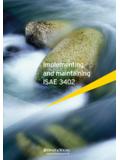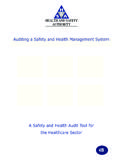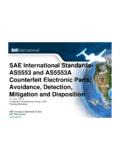Transcription of Monitoring the system of internal control - BOARD …
1 Monitoring the system of internal control The audit committee guide seriesContents 2 COSO guidance 3 internal control objectives 4 Monitoring internal control 7 Roles and responsibilities 9 Reporting requirements14 audit committee expectations 15 Grant Thornton s internal audit services 18 Suggested reading19 Offi ces of Grant Thornton LLP Effective audit committees are critical to the quality of fi nancial reporting and the proper conduct of business. This guide is one of a series that is meant to help audit committees meet their oversight and fi duciary responsibilities. Trent Gazzaway, National Managing Partner of audit ServicesThe audit committee guide series has been adapted from The audit Committee Handbook, Fifth Edition, published by John Wiley & Sons and available for purchase at and through major online booksellers and bookstores passed in recent years requiring management and others to report on the effectiveness of internal control over fi nancial reporting (ICFR) are rooted in the expectation that good business practices are in place.
2 They do not specifi cally require the establishment of new, large compliance departments. An organization that had good internal control including good Monitoring procedures before the passage of these laws should be able to comply with the existing reporting requirements without a dramatic, long-term increase in cost or the system of internal control 1 How will fi nancial reform impact your company?The regulatory landscape is changing for companies and their audit committees. Go to to review Grant Thornton s outline of key fi nancial reform issues and actions you can take to guide your company through them: Financial reform: What public companies and their audit committees need to know about the Dodd-Frank Act. COSO guidanceThe Committee of Sponsoring Organizations of the Treadway Commission (COSO) 2009 Guidance on Monitoring internal control Systems1 was designed to help management better utilize its organization s existing internal control Monitoring procedures to support its assertions, rather than building a separate and often ineffi cient process to comply with Section 404 of the Sarbanes-Oxley Act of 2002 (SOX).
3 The various forms of international guidance on internal control ( , COSO Framework, CoCo and the Turnbull Guidance) are indistinguishable in most respects. Of all the guidance, COSO s Framework has been vetted most extensively2 and is the framework used by most public companies. The following discussion about internal control and Monitoring draws heavily from both the COSO Framework and COSO s 2009 Monitoring guidance. 1 Available at 2 COSO s internal control Integrated Framework was the fi rst major framework published in 1992. Its Guidance on Monitoring internal control Systems (published in 2009) was developed over a two-year period that included two public comment Monitoring the system of internal controlOrganizations should have effective internal control systems, and should monitor those systems to ensure that they remain the system of internal control 3 3 See COSO Framework, Ch. control objectivesThe COSO Framework says, internal control is a process, effected by an entity s BOARD of directors, management and other personnel, designed to provide reasonable assurance regarding the achievement of objectives in the following categories: Effectiveness and effi ciency of operations, Reliability of fi nancial reporting, Compliance with applicable laws and regulations.
4 Organizations meet these objectives through a process that includes fi ve primary components:3 control environment Risk assessment control activities Information and communication MonitoringThe interrelationship between the three objectives and the fi ve components, operating across organizational boundary lines, is often depicted in the graphic shown in Exhibit 1 The COSO Framework CubeCopyright 2004-2010, The Committee of Sponsoring Organizations of the Treadway Commission. All rights reserved. Reprinted with internal controlCOSO s 2009 Monitoring guidance shows how these components fi t together as an overall process, and how Monitoring covers all fi ve components (Exhibit 2).The COSO Framework states that Monitoring ensures that internal control continues to operate effectively. 4 Monitoring should evaluate (1) whether management reconsiders the design of controls when risks change, and (2) whether controls that have been designed to reduce risks to an acceptable level continue to operate COSO Framework, Monitoring the system of internal controlExhibit 2 Monitoring Applied to the internal control ProcessCopyright 2004-2010, The Committee of Sponsoring Organizations of the Treadway Commission.
5 All rights reserved. Reprinted with Monitoring is effective, it provides the necessary support for management and others who are charged with governance to be confi dent that internal control is operating effectively at any given point in time, including at the end of the year when formal assertions by management may be committee members should note that large, fourth-quarter efforts, designed solely to comply with Section 404 of SOX or similar reporting requirements, likely are indicative of:1. inadequate Monitoring procedures earlier in the year,2. a weak internal control system that needs correction, and3. a duplication of effort already addressed by the organization s effective Monitoring perform their most effective Monitoring when they focus on gathering and evaluating persuasive information about the operation of key controls that address meaningful risks to their This process includes the following:61. Understanding and prioritizing risks to organizational objectives2.
6 Identifying key controls across the internal control system that address those prioritized risks3. Identifying information that will persuasively indicate whether those controls are operating effectively4. Developing and implementing cost-effective, ongoing or periodic evaluations that evaluate that persuasive informationMonitoring the system of internal control 5 5 See COSO s Guidance on Monitoring internal control Systems, vol. I, par. Ibid., par. Monitoring expends minimal time or effort on risks that are not meaningful or on controls whose evaluation is not necessary to support a conclusion about internal control effectiveness. It is important, then, to understand the defi nition of key controls. COSO s Monitoring guidance defi nes key controls as having one or both of the following characteristics: Their failure could materially affect the objectives for which the evaluator is responsible, but might not be detected in a timely manner by other controls.
7 Their operation may prevent other control failures or detect such failures before they have an opportunity to become material to the organization s intent of identifying key controls is to help organizations devote Monitoring resources where they can provide the most value. If a given control s failure is likely to be immaterial to the fi nancial statements, or to be detected and corrected in a timely manner by other controls, then perhaps Monitoring should focus on those other controls. Understanding this dynamic can help the audit committee ensure that management, the internal auditor and the external auditor have an appropriate internal control evaluation Monitoring the system of internal control7 Ibid., par. the system of internal control 7 Roles and responsibilities Everyone in an organization shares some responsibility for internal control . Their roles and responsibilities can be characterized as follows: ManagementThe chief executive offi cer ultimately is responsible for and should assume ownership of the system .
8 The chief executive, above others, sets the tone at the top that affects integrity, ethics and other attributes of a positive control environment. Large-company CEOs fulfi ll this duty by providing leadership and direction to senior managers, and reviewing the way they control their units business. In smaller organizations, the infl uence of the chief executive (often an owner-manager) is usually more of directors Management is accountable to the BOARD of directors, which provides governance, guidance and oversight. Effective BOARD members are objective, capable and inquisitive. They also have knowledge of the entity s activities and environment, and commit the time necessary to fulfi ll their BOARD responsibilities. The BOARD can be particularly effective when sound upward communications channels and capable fi nancial, legal and internal audit functions are in committee audit committee member responsibilities are separate and apart from those of conventional BOARD members.
9 The audit committee generally is responsible for overseeing the accounting and fi nancial reporting processes of an organization, and for the appointment, compensation and oversight of the external This is especially true under the Sarbanes-Oxley requirements for audit committees of public See NYSE Rule (c)(iii)(D).10 Securities and Exchange Commission, Release No. 34-50298 (Washington, DC: SEC, August 31, 2004 ( )), Section 303A(7)(c)(iii)(H), 23 See SAS No. 115, par. 1; and ISA 265, par. Monitoring the system of internal control In addition, audit committees of companies listed on the New York Stock Exchange are obligated to review their organization s risk management The New York Stock Exchange went further by specifying additional audit committee oversight expectations through a modifi cation to Section 303A of its Corporate Governance Regardless of the audit committee s area of focus, its role is one of oversight, not execution.
10 audit committee procedures should be focused on (1) understanding the risks, and (2) verifying that management, the auditors and others are focused appropriately on those risks. To that end, an effective internal audit function is a valuable tool to the audit committee. internal auditorsInternal auditors play an important role in evaluating the effectiveness of control systems and contribute to ongoing effectiveness. Because of its organizational position and authority in an entity, an internal audit function often plays a signifi cant Monitoring personnelVirtually all employees are responsible either for producing information used in the internal control system or for taking other actions needed to effect control . A responsibility shared by all personnel is that of upward communication of operations problems, code of conduct noncompliance, and other policy violations or illegal parties External parties often contribute to an entity s achieving its objectives.





